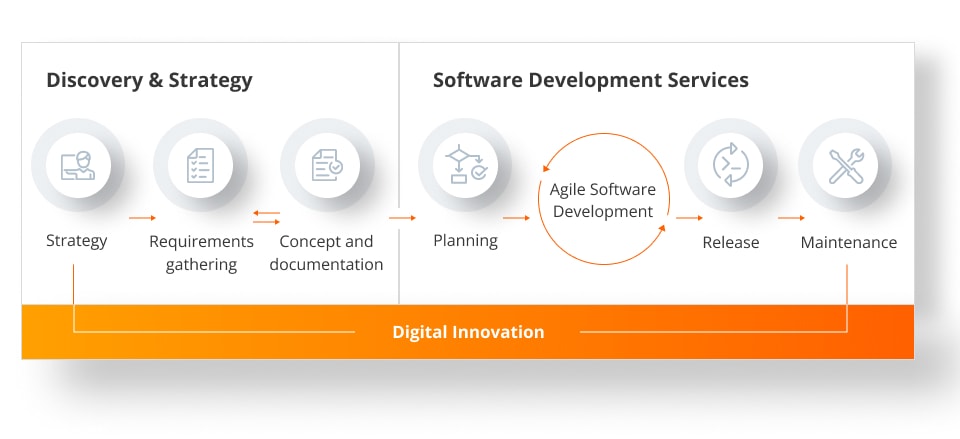
Accelerate your transformation
Are your current technology and systems enough to do the job you need? Are you planning to optimise your existing resources, to upgrade your services or are you going through a complex digital transformation of your business?
Due to the global COVID-19 pandemic, companies had to cope with the new reality without prior planning and preparation. This feels like the beginning of a new era when technological strategies no longer refer to planning each change step by step, but to maintaining the highest level of adaptability, creativity and resilience under all conditions. It’s a great step to make, but one that has to be well planned as well.
Today, technology plays a key role in shaping business strategy and, consequently, the role of an IT leader has been growing in importance for the whole company. IT leaders are now engaged in driving strategic initiatives and creating value for the company and are no longer confined to only cater to organisational needs. And software product design capabilities are irreplaceable in achieving these goals.
According to McKinsey, large IT projects run on average 45% over budget and 7% over time while delivering 56% less values than predicted. 17% of IT projects go so bad they can threaten the existence of a company.
The changing role of an IT C-level executive
The role of an IT C-level executive is different today. Nowadays, they need to transform IT into a source of innovation by making the most of opportunities that technology offers. It’s no longer a choice but a necessity.
In the same report, it is stated that 96% of the CIOs declare that their role is expanding beyond traditional IT responsibilities and that today they spend much more time on tasks related to aligning IT projects with business goals (44%) and leading business innovation (34%).
C-level executives are now responsible for creating a digital backbone that will help their company accelerate digital transformation. They need to cope with a mounting set of responsibilities having to break the status quo, suggest the need for using new technologies, refine business strategy or identify opportunities.
C-level executives are also the ones who need to combine these numerous competences with being a good leader and bringing value to the organisation itself. In the next years digital strategies will mostly draw from:
Reading Deloitte’s Wall Street Journal Intelligence survey, we discover that 40% of CEOs said their CIO or tech leader will be the key driver of business strategy.
Today, innovation is at the centre of business strategy. And, as stated by Deloitte, in 2021 the distinction between corporate strategy and technology strategy is blurring and organisations need lean leaders who take a high-level approach. And this is challenging. As a modern-day C-level IT executive it is your role to ensure your project is among the successful ones. How can you make that happen?
As a modern-day C-level IT executive it is your role to ensure your project is among the successful ones. How can you make that happen?
If you’re planning a digital transformation or building a new software product, gather data, define the requirements well at the beginning and ensure your tech initiatives take into consideration the needs of your audience.
Engage product design specialists, build a strategy that your business needs and stay ahead of the game.
Product Design – why worth your time?
Going through the process of software product design reduces project risks such as delays, failure to implement a certain scope of the project, unplanned increase in costs or poor evaluation of the usefulness of the new solution by end users.
Working with product design specialists gives you the possibility to fully use your current resources and potential. You get specialist feedback, recommendations and know which way to go to achieve the best results.
Software product design should therefore be seen as an investment – the more effort you put into the early stages of building a product, the better the outcome will be.
| What Wastes your time? | WhAT SAVES YOUR TIME? |
| Building a product based on a business model that is not confirmed. Consequently, the final product may fail because of aspects that were not checked before and turned into blockers. | DEFINING YOUR BUSINESS MODEL Design your model of monetisation of services and adjust it to your market and business needs. |
| No main vision of the product, building it in chaotic way or in parts that are not consistent. This approach leads to making more changes, longer and more expensive development. | DEFINING YOUR PRODUCT VISION Workshops allow to define your product’s vision, business objectives and to establish a common understanding of the business goals. |
| A lack of understanding of users’ real needs and behaviours. It leads to product development based on assumptions and can prove to be an expensive mistake. | DISCOVERING USERS’ NEEDS Get to know your customers, understand their needs and minimise the risk of oversight or mishap during development. |
| Lack of market verification may result in the product not being used by customers. It may also result in duplication of existing solutions without having a definite advantage and differentiators. | UNDERSTANDING THE MARKET Conduct market research and gather recommendations of functionalities. |
| Relying on complex descriptions of vision and product hinders communication and verification of the expected effect. The same sentence can be understood in different ways it’s good to bet on visual materials. | MAKING IT VISUAL FROM THE START Prepare mockups and semi-interactive prototypes and verify your assumptions without the need for costly coding. |
| Lack of visual and functional consistency leads to poor usability of the product. It also lengthens the process of learning. | MAINTAINING CONSISTENCY Produce UX guidelines, provide instructions for technical and graphic development and ensure consistency of the application. |
Working with software product design specialists helps you ensure the best customers’ experience and adjustment to their needs. And all these delivered with no delays and unplanned costs.
Services that deliver real value
To benefit most from the software product design, it’s worth engaging into related services that are mostly run in the form of workshops. When well-carried they help meet all business challenges, fill the gaps in the strategy/ idea for the project and facilitate implementing digital innovation in your company.
There are various types of software product design workshops and each of them should be tailored uniquely to your needs. Every company is different, so every workshop should be.
We’ve been actively participating in the market and answering our clients’ needs for over 20 years and we are bringing you our know-how.
You can choose from an IT Strategy Workshop, Design Sprint Workshop or a Discovery Workshop.
IT Strategy Workshop
The IT Strategy Workshop involves analysing your company’s figures, performance, key processes, business needs, challenges and opportunities, as well as industry trends. Everything that you need to help you make strategic decisions.
If you have a business problem, you’re thinking about the digital transformation or developing a software product, but still have some doubts and need guidance on a strategic level – choose the IT Strategy Workshop.
Goals
The IT Strategy Workshop is designed to help solve your business problems with up-to-date technology no matter if you need an overall IT strategy, or just a plan for developing a single product. Before making any big investments, you will receive knowledge to reduce any risks associated with the implementation of your project.
Design Sprint Workshop
A design sprint is a 5-day workshop that allows you to design and evaluate your idea for a product prior to development. All you need is to have a small budget available and the active engagement of key stakeholders and user representatives for the duration of the workshop.
If you have a specific idea in mind or experience to improve and can’t wait to see the shape of a final product and your customers’ reactions to it – bet on the Design Sprint Workshop.
Goals
During this highly productive 5-day period, your idea is clearly defined, evaluated by experts, turned into a working prototype, and thoroughly tested.
Discovery Workshop
The Discovery Workshop helps clarify your idea and ensure that your product/service is perfectly adjusted to your business objectives and customer needs.
If you are thinking about going digital and already have some vague ideas, but also need a specific roadmap to help your development team get started – select the Discovery Workshop.
Goals
The Discovery Workshop will help you find a solution that is right for you. You will receive assistance in setting objectives, planning new features, and creating and testing your MVP. The entire scope of the workshop, as well as certain activities, can be easily adjusted to your project and requirements.
Valuable competences in your project
Yes, developers write the code. But apart from them there is a number of software product design specialists who are worth engaging in your project, such as:
- Business Analysts,
- User Experience Specialist,
- Technical Architects.
You can also benefit from involving external experts on artificial intelligence, machine learning, or cloud computing.
What is crucial is to well adjust the team engaged in your project and software design service to your business needs.
BUSINESS ANALYSTS
They are responsible for gathering, analysing and distributing the knowledge related to the product at the beginning of the project and constantly during its course. They also serve as a source of knowledge and a constant point of contact for all the questions and suggestions about the product.
They are also the ones who should know who holds the knowledge about specific parts of the systems and processes.
According to the Standish Group report, among the top five factors found in successful projects are user involvement and clear statement of requirements.
USER EXPERIENCE SPECIALISTS
Engagement of User Experience (UX) specialists will help you to create a project with the humancentred approach. And that’s exactly what you need. Why?
Their work provides your customers with better digital experience, encourages them to spend more time with your solution and brings real financial value to the company.
According to the Future Experience Survey by PWC, over 50% of web visitors find a product’s design and mobile experience very important. When it comes to generation Z, the group exceeds 60%.
TECHNICAL ARCHITECTS
They are responsible for the entire system and should be engaged in development of functional and nonfunctional requirements before the development team starts working on a project.
Technical architects work with the client since the conceptual phase of the project in order to understand the domain and business needs of the system (together with BA). They ensure business goals corresponds with the client’s needs.
Their early influence allows to minimise costs and potential risks. Technical architects are technical leaders in projects who not only create technical vision but also make sure that development teams follow it in a clean and consistent way within the expected time.
Thanks to engaging specialists from various areas, software product design services are a hybrid of design, UX, technology as well as comprehensive business analysis.
This unique approach enables companies to look at your idea from various perspectives and correctly evaluate it.
Software Product Design is never the same. Each specific domain with all its rules, users and existing business processes, to be simplified requires individual approach and a set of specialist competencies. Gathering people with different expertise and working in a team gives us synergy necessary to create the right product in the right way.Agata BilnickaLead UX Designer, Future Processing
Yes, it works
Engaging software product design specialists helps delivering IT product strategy that our clients implement.
The workshop help to plan a software solution that is compliant with security standards and easy when it comes to future maintenance and developing additional features.
During the workshop the focus is laid on:
- creating the roadmap for the product,
- analysing pain points and constrains of the current application,
- planning non-functional aspects of the technical solution.
Have a closer look at the projects we delivered and check our Behance Portfolio!
Free tools
Do you want to find out more? Why not start by downloading some of the tools to help you with product design?
Product design checklist
Check what you already have in terms of the software product design and what is still missing. Ensure that you do not forget about any important aspect and run your project smoothly.
RFP template for Software Product Design
Collect responses on approaches to software product design proposed by various software providers, select the best IT partner to tackle your particular challenge and define the needs of your organisation.
Software requirements specification template pack
A software requirements specification allows you to present your idea and needs in a well-structured manner which can be later shared with the development team. Download it if you need a requirements specification template for a new or existing software development that you want to upgrade.
IT Strategy & Discovery Workshop: the decision path
Use a diagram prepared by software product design specialist, answer the questions and check which workshops are the ones your business needs right now.
Summary
Do you want to start your digital transformation but have no idea how? Do you miss a grand vision? Did you get lost in new challenges? Do you face problems that are completely unexpected? Or maybe you’ve come up with a vague outline of a new and exciting product that still needs to be validated or polished?
If you are faced with these issues engaging software product design specialists in a way to find best solutions to your business challenges. Align IT projects with your company’s goals and successfully lead the business innovation.







